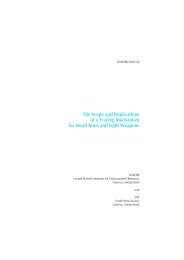Download - Small Arms Survey
Download - Small Arms Survey
Download - Small Arms Survey
Create successful ePaper yourself
Turn your PDF publications into a flip-book with our unique Google optimized e-Paper software.
KAZAKHSTAN 109<br />
A SAFE HAVEN UNDER THREAT?<br />
Kazakhstan, the world’s largest landlocked country, is home to just 16.6 million inhabitants (AS, 2011). A Soviet<br />
Republic until December 1991, it now shares borders with China, Kyrgyzstan, the Russian Federation, Turkmenistan,<br />
and Uzbekistan. Unlike some of its Central Asian neighbours, Kazakhstan has been spared civil war and ethnic strife,<br />
earning it the reputation of a pillar of stability in an otherwise volatile region. 5 This section tests this assessment by<br />
reviewing key crime and security indicators and by discussing emerging threats to the country’s internal stability. It<br />
finds that the overall security situation is satisfactory, although it is becoming more vulnerable to emerging negative<br />
trends. While crime rates have decreased markedly since Kazakhstan’s independence, the past two years have seen<br />
a significant deterioration. Recent acts of religiously motivated terrorism, as well as instances of ethnic and political<br />
violence, further cloud the picture.<br />
Context<br />
Kazakhstan has prospered economically over the past decade thanks in large measure to its booming oil and gas<br />
industries. Gross national income per capita increased from USD 1,260 in 2000 to USD 7,440 in 2010 (World Bank,<br />
2011). Kazakhstan is also Central Asia’s primary recipient of foreign direct investment, with USD 50 billion received<br />
since 1991, representing around 80 per cent of total investment in the Central Asia region (Hug, 2011, p. 21). Economic<br />
growth has generally contributed to improving socio-economic conditions, particularly in the last ten years. From 2001<br />
to 2009, the proportion of the population with income below the minimum food basket declined from 16.1 per cent<br />
to 0.6 per cent, while income inequality decreased by 30 per cent (UN, 2010, pp. 18–19). Unemployment officially<br />
stood at a low 5.3 per cent for the third quarter of 2011 (AS, 2011).<br />
Growing economic significance and political stability have helped turn Kazakhstan into a regional powerhouse<br />
with increasing clout in international forums. In 2010, Kazakhstan became the first Central Asian state and former Soviet<br />
Republic to chair the Organization for Security and Co-operation in Europe (OSCE). During its presidency, Kazakhstan<br />
hosted the OSCE’s first heads of state summit in 11 years (Lillis, 2011b; OSCE, 2010). The country was also named chair<br />
of the Shanghai Cooperation Organization in 2011 as well as of the Organization of Islamic Cooperation in 2011–12<br />
(RoK, 2011c; MFA, 2011).<br />
Tarnishing these positive features are persistent concerns with governance in the country. President Nursultan<br />
Nazarbayev has led Kazakhstan since 1989 and was last re-elected in April 2011 for a five-year term with 95.5 per cent<br />
of the vote. Although the turnout rate of 90 per cent was lauded, foreign observers, including the OSCE, expressed<br />
concern at the lack of opposition candidates and noted ‘serious irregularities’ in the electoral process (Lillis, 2011c;<br />
OSCE, 2011). Furthermore, Kazakhstan is accorded a score just above mid-level in the United Nations Development<br />
Programme’s Human Development Index, ranking 66 out of 169 countries (UNDP, 2010). Shortcomings in the country’s<br />
healthcare and education systems contribute to the modest ranking and stand in sharp contrast to the flattering<br />
macro-economic trends mentioned above (ICG, 2011, pp. 28–33). Social tensions also surfaced in 2011 when massive<br />
protests by oil and gas workers demanding higher wages affected the national industry for several months (RFE/RL,<br />
2011). In December 2011, a peaceful strike turned violent, leading to pogroms and deadly clashes in the towns of<br />
Zhanaozen and Shetpe, in which at least 17 people died after police and security forces fired on a crowd of rioters<br />
(Antoncheva, 2011).<br />
Kazakhstan is<br />
becoming more<br />
vulnerable to<br />
emerging negative<br />
trends.

















